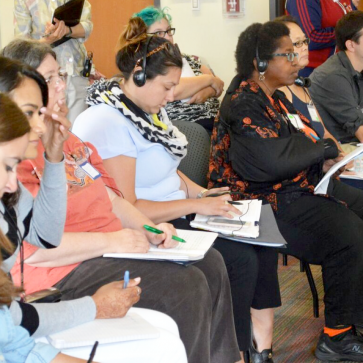This course supports your team to conduct a Lesson Study cycle on fractions. Your team should include at least one grade 3-5 teacher who will be teaching a fractions unit.

Develop the Teaching-Learning Plan
The Teaching-Learning Plan for a research lesson differs from an ordinary lesson plan because it is designed to stimulate, capture, and share your group’s learning, as well as to support the lesson instructor. The plan represents the thinking of the whole group about three concentric layers of practice—the lesson itself, the larger unit and subject area of which it is part, and the even larger domain of students’ long-term development of qualities like sense-making and persistence. As you move from planning to teaching the research lesson, your Teaching-Learning Plan will:
- Support the lesson instructor by providing a detailed outline of the lesson and its logistical details (e.g., time, materials, wording of key questions);
- Help your group anticipate student thinking, including misconceptions, and plan how student responses will be used to build learning within the lesson;
- Help observers understand why your lesson is designed as it is, and what you hope to accomplish by teaching it;
- Guide observers on data they should collect;
- Provide forms to support careful observation, such as a student seating chart, Lesson Observation Notes (found at the end of Section 5), and a copy of the student task(s); and
- Capture your team’s learning about this topic, so others can learn from it.
As you plan the research lesson, avoid the temptation to micro-manage each move and comment of the lesson instructor. Decisions such as whether to have a discussion at desks or gathered on the rug are best left to the instructor, unless these decisions closely relate to the aspects of student learning under study by the group—for example, perhaps it is important for students to be at desks so they can record their thinking in notebooks.
Dr. Takahashi’s lesson plans for the series of California lessons you watched on video, which can be found here, may provide a useful reference as you write your plan.
Develop the rest of the Teaching-Learning Plan for the research lesson, continuing to use the template you downloaded during Module 1. If time is short, you can skip item #2 of the Teaching-Learning Plan (Research Theme) or briefly describe your long-term vision for students as learners. When you reach #7 of the Teaching-Learning Plan (“Data to Collect”), here are some additional thoughts to support your planning about data collection:
- “Points to Notice,” the right-hand column of the “Lesson Design” table, notes what observers should look for in students at each stage of the lesson–for example, how students interpreted the problem posed at the outset, what solution strategies they initially tried, and how and why their thinking changed during the lesson.
- One particularly valuable form of data is narrative observations of several focal students of different achievement levels across the entire lesson, so you understand the lesson through their eyes. We recommend that you anticipate the thinking of these students and note it in the Teaching-Learning Plan, so you can later compare your ideas with their actual responses.
